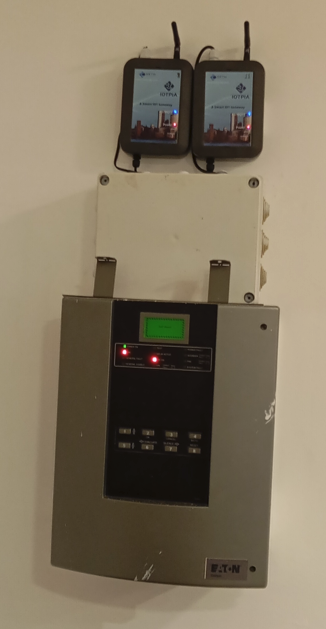
Centralized Remote Fire Monitoring
The solution upgrades the classical fire alarms installed in multiple remote buildings with sensors to monitor all the remote fire alarms and enable customers to have a real-time web-based map and centralized siren available inside a centralized operation center to monitor the status of all the remote fire alarms distributed allover multiple buildings. The solution also sends notifications and SMS alerts to managers of impacted buildings in case of fire alarm in a building.

1. Drastically Reduced Response Time (The "Golden Hour" Impact)
Immediate Awareness: Classical alarms rely on someone being physically present to hear the bell and then call the fire department. Our solution eliminates "human latency." The moment a sensor trips, the centralized operations center knows.
Pinpoint Accuracy: With the web-based map, responders don't just know "there is a fire on the campus"; they know exactly which building is affected. This allows fire trucks to drive directly to the specific hazard zone without wasting minutes searching.
2. Cost-Effective Retrofitting (CapEx Savings)
Protecting Legacy Investment: Instead of "rip and replace"—which involves expensive rewiring, new control panels, and construction downtime—this solution leverages the existing infrastructure. It makes "dumb" alarms "smart" for a fraction of the cost of a full system upgrade.
Scalability: It is easy to add new buildings to the dashboard without needing to buy a whole new proprietary software suite for every location.
3. Elimination of Information Silos
Single Pane of Glass: For organizations with scattered real estate (e.g., university campuses, logistics hubs, retail chains), managing safety is usually fragmented. This solution provides one holistic view.
Standardized Protocol: It ensures that a fire in a remote warehouse triggers the same high-level response protocol as a fire in the headquarters, removing the risk of remote locations being "forgotten."
4. Targeted & Redundant Communication
Role-Based Alerts: The SMS/Notification feature ensures the right people know immediately. You don’t need to alert the whole company for a localized issue, but you ensure the specific building manager is notified instantly to begin evacuation or unlock gates for fire trucks.
Bypassing Local Failures: If a local building's phone lines are down or the local security guard is incapacitated/absent, the cellular/internet-based transmission ensures the alarm still reaches the central center.
5. Insurance and Liability Reduction
Lower Premiums: Insurance companies often offer significant discounts for buildings with 24/7 active remote monitoring because it statistically reduces the "total loss" risk.
Audit Trails: The system logs exactly when the alarm went off, when the notification was sent, and when it was acknowledged. In the event of an incident, this digital paper trail is crucial for legal defense and insurance claims.
6. Proactive Maintenance & Health Checks
System Integrity: The solution can detect if a remote panel loses power or goes offline. This prevents the nightmare scenario where you only find out a fire alarm was broken after a fire has already started.
7. Business Continuity
Minimize Downtime: By catching a fire in the "smoldering" phase via rapid alerting rather than the "engulfed" phase, you limit damage to a single room rather than a whole building. This means the business can get back up and running days sooner.